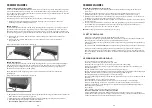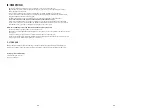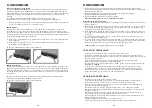
4
5
UK: INSTRUCTION MANUAL
UK: INSTRUCTION MANUAL
Connecting your appliance to a gas cartridge
Please see TECHNICAL DATA table for information regarding regulator and hose. Only use a regulator
complying with EN16129 and a hose complying with EN16436. The length of the hose shall not exceed
150 cm. Both regulator and hose must also comply with national regulations.
Replace the hose according to national regulations. Avoid twisting the hose.
Always read the manual regarding the regulator and hose.
Never leave the regulator attached to the gas cylinder if disconnected from the gas hose.
1. How to connect your gas grill to a gas cylinder depends on which model you have purchased.
Please read the instructions below for your Rukutu model.
Rukutu (650787):
To be able to use your gas stove you will need to purchase an LPG gas cylinder, a regulator and a hose.
The type of gas can be butane or propane. The regulator needs to fit the chosen gas cylinder and deliver
a supply pressure of 28-30mbar if the gas is butane. 30 or 37 mbar if the gas is propane. The hose needs
to fit the regulator as well as the gas stove. The gas stove can be used with either 8mm ID or
10/11mm ID.
a) If your hose has an internal diameter of 8 mm, push the hose over the first ribbed half of the hose stud.
b) If your hose has an internal diameter of 10/11 mm, push the hose all the way over the ripped part of
the hose stud (4).
The hose should be threaded hand tight plus ¼ of a turn.
Rukutu - DE (650788):
To be able to use your gas stove you will need to purchase an LPG gas cylinder and regulator (the hose
is supplied with your gas grill). The type of gas can be butane or propane. The regulator needs to fit the
chosen gas cylinder and deliver a supply pressure of 50mbar. The hose needs to fit the regulator as well
as the gas stove. The gas stove is equipped with a ¼” LH thread.
The supplied 80 cm hose is equipped with a ¼” LH thread and can be threaded directly onto the gas inlet
connection.
The hose should be threaded hand tight plus ¼ of a turn.
2. Once you have successfully connected your gas stove to a gas cylinder, position the gas cylinder at
the side of your gas stove. Keep in mind that the cylinder must be kept away from heat and in a safe
and upright position.
3. Attach the regulator to the gas cylinder tap correctly (refer to the instruction manual provided with
the regulator).
4. Always check for leaks at all joints using soapy water. NEVER USE A NAKED FLAME TO CHECK FOR LEAKS.
How to light the burners (2) and grill (9):
1. Slowly open the gas by turning the relevant control knob(s) (5) slowly counterclockwise from the
symbol “•”.
2. Turn the piezo ignition button clockwise to ignite. If it fails to ignite after 3-5 attempts. Close the
control knobs (5) and wait 5 minutes to allow for the unburned gas to evaporate, before making a
new attempt.
3. When the burner is lit, turn the control knob(s) (5) clockwise (towards symbol “•”) to decrease the
flame and heat intensity or extinguish, and counterclockwise to increase.
4. For maximum efficiency, ensure that the flames of the burner(s) (2) do not overlap the base of the
pan/pot.
5. Make sure the flame on the appliance is steady. The flame shall always leave the appliance straight
upwards. Wind may press the flame down underneath the burner. If this happens stop use of the
appliance and move it to a more wind sheltered place.
WARNING: Turn off the gas supply at the gas cylinder after use.
3. CHANGING THE GAS CYLINDER
• Turn off the appliance completely. Be careful the gas cylinder could be hot.
• The gas cylinder shall be changed in a well-ventilated location, preferably outside, away from any
sources of ignition, such as naked flames, pilots, electric fires and away from other people.
• Check the seals before connecting a new gas cylinder to the appliance. Follow the manuals of the gas
cylinder and gas regulator.
• To ensure a safe connection of a new gas cylinder to your appliance please read the sections
‘ASSEMBLY’ and ‘OPERATION’.
• If there is a leak on your appliance (smell of gas), turn off the gas supply and take it outside
immediately into a well-ventilated flame free location where the leak may be detected and stopped.
If you wish to check for leaks on your appliance, do it outside. Do not try to detect leaks using a flame,
use soapy water.
4. CLEANING & MAINTENANCE
• Ensure the appliance is cool before cleaning
• Check the good operation of the gas cylinder connection/disconnection system.
• Visually check the general condition of the appliance and clean it if necessary.
• If the appliance has not been used for some time, check the venturing pipes before use for spider
webs or other obstructions.
• Use a wire brush, steel wool or a scouring pad to clean the grid(s) (6).
• Use a soft cloth with warm soapy water to clean the grill griddle (8) to avoid any scratches on the
coating.
• Do not use metal utensils on the grill griddle (8) as this will damage the coating.
• Please discard grill griddle (8) if the coating is cracked or damaged.
• Interior surfaces of the appliance housing cover should be washed with hot soapy water. Make sure
to dry immediately.
• Remove the drip tray (11) and clean it with soapy water.
• Visually inspect that the venturis are not blocked by debris. Clean if necessary.
• If the burner ports become clogged, do not use a metal object to clean them.
• If you suspect a gas leak or malfunction, stop using immediately, extinguish and disconnect
• from the gas cylinder.
• Check for leaks at all joints using soapy water. NEVER USE A NAKED FLAME TO CHECK FOR LEAKS.
• If gas pressure drops or the gas will not light, check if there is gas left in the cylinder.
• If you are not able to rectify any fault following the abovementioned instructions, contact the dealer
or Outwell Customer Service (contact details below).
a)
b)




































